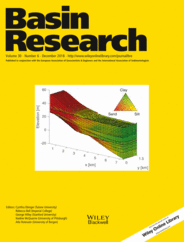
Full text loading...
Differentiating compressional growth strata from halokinetic sequences is not straightforward in foreland fold‐and‐thrust belts where compressional and diapiric processes were coeval. Although there are numerous studies on the role of salt layers in fold‐and‐thrust belts, very few focus on syntectonic evaporites where they are thick enough to develop diapirism. The tectonic structures of the northern Dezful Embayment, along the footwall of the Zagros Mountain Front Fault, show a complex evolution interpreted in this study by the concurrence of folding, thrusting and pre‐ and syn‐shortening diapirism of the lower Miocene Gachsaran evaporites. We explore this tectonic–diapiric–sedimentary interplay by combining field studies and remote‐sensing mapping, detailed stratigraphy and sedimentology, high‐quality seismic data, and step‐by‐step balanced tectono‐sedimentary restorations. Initial diapirism occurred soon after the deposition of at least 1.5 km thick Miocene Gachsaran evaporites during the sedimentation of up to 5 km thick Aghajari, Lahbari and Bakhtyari formations, which display syntectonic mixed growth strata and halokinetic sequences. These sedimentary sequences filled salt‐related minibasins, from which the Azanak Minibasin is the deepest, limited by growing salt walls and salt anticlines (Azanak thrust‐weld and the Saland–Lali anticline). Palaeocurrents and clasts compositions document fluvial diversions and exposure and erosion of Gachsaran evaporites along the active salt walls. Although, by further shortening, the precursor salt walls squeezed and reactivated as thrust‐welds structuring a duplex of overriding minibasins. During the deposition of the middle‐late Miocene Aghajari Formation, Kazhdumi and Pabdeh source rocks were buried to oil‐expulsion depths, and Sarvak and Asmari reservoirs were mildly folded in large and open anticlines. The Gachsaran system in the northern Dezful Embayment is collated with the structures of preshortening Hormuz salt and syn‐shortening Fars salt to highlight the important role of these ductile units in the tectonic evolution of the Zagros fold belt that is compared to syn‐compressional salt‐related Pyrenees, Carpathians, Sivas and Kuga fold belts.

Article metrics loading...

Full text loading...
References


Data & Media loading...
Supplements

